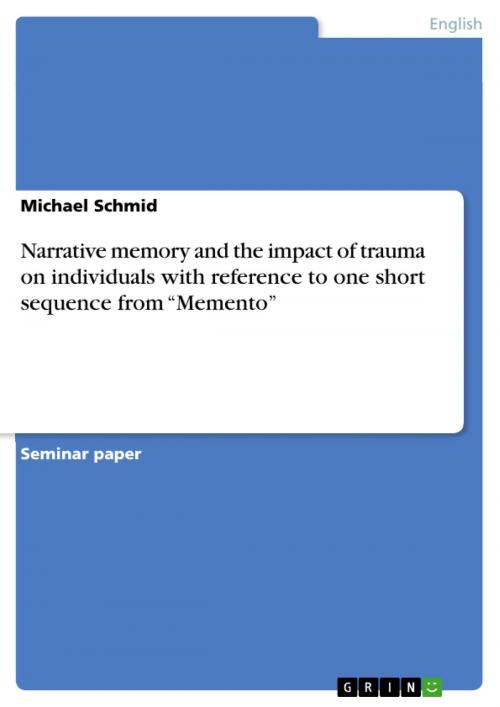Narrative memory and the impact of trauma on individuals with reference to one short sequence from 'Memento'
Nonfiction, Entertainment, Drama, Anthologies| Author: | Michael Schmid | ISBN: | 9783638590785 |
| Publisher: | GRIN Publishing | Publication: | January 12, 2007 |
| Imprint: | GRIN Publishing | Language: | English |
| Author: | Michael Schmid |
| ISBN: | 9783638590785 |
| Publisher: | GRIN Publishing |
| Publication: | January 12, 2007 |
| Imprint: | GRIN Publishing |
| Language: | English |
Seminar paper from the year 2004 in the subject American Studies - Culture and Applied Geography, grade: 1,3, Free University of Berlin (John F. Kennedy Institut Berlin), course: HS American Cultural Memory: Trauma, Collective Imagery and the Politics of Remembering, 3 entries in the bibliography, language: English, abstract: The text by Bessel Van der Kolk and Onno Van der Hart 'The Intrusive Past' provides an overview of the work and achievement of Jean - Martin Charcot´s and Pierre Janet's study about how the mind processes memories and the effects of traumatic memories on consciousness. With the following text, I will present a couple of central aspects of Janet's study and the phenomena of dissociation and the reconstruction of the past through narrative memory and project them onto one short sequence from 'Memento' (2001) to further support my argument. The main point of this text is to illustrate how narrative memory reshapes the past in a variety of ways and that the main character in 'Memento', who has lived through a traumatic experience, creates and recreates his past through the means of a combination of the already mentioned dissociation and narrative memory. Janet considered 'the memory system as the central organizing apparatus of the mind, which categorizes and integrates all aspects of experience and automatically integrates them into ever - enlarging and flexible meaning schemes.' He differentiates between the subconscious automatic integration of familiar and expectable experiences into existing meaning schemes and the difficult integration of frightening and novel experiences, which might either totally resist integration or be remembered extremely vivid. The subconscious integration of memories occurs because they fit easily into the meaning scheme, they do not pose a threat or form a contradiction to the already existing beliefs, values and meanings of the world. Whereas the automatic integration of new information happens without conscious attention, the narrative memory is something very deliberate and conscious. Narrative memory is not the act of remembering something that happened in the past but an act of recreating the past, of changing the memory. Janet explains this phenomena as mental constructs, 'which people use to make sense out of experience.' This suggests that the individual's existing meaning schemes may be entirely unable to integrate a specific terrifying experience, which causes the memory to be stored differently, and therefore might not be available for the act of remembering.
Seminar paper from the year 2004 in the subject American Studies - Culture and Applied Geography, grade: 1,3, Free University of Berlin (John F. Kennedy Institut Berlin), course: HS American Cultural Memory: Trauma, Collective Imagery and the Politics of Remembering, 3 entries in the bibliography, language: English, abstract: The text by Bessel Van der Kolk and Onno Van der Hart 'The Intrusive Past' provides an overview of the work and achievement of Jean - Martin Charcot´s and Pierre Janet's study about how the mind processes memories and the effects of traumatic memories on consciousness. With the following text, I will present a couple of central aspects of Janet's study and the phenomena of dissociation and the reconstruction of the past through narrative memory and project them onto one short sequence from 'Memento' (2001) to further support my argument. The main point of this text is to illustrate how narrative memory reshapes the past in a variety of ways and that the main character in 'Memento', who has lived through a traumatic experience, creates and recreates his past through the means of a combination of the already mentioned dissociation and narrative memory. Janet considered 'the memory system as the central organizing apparatus of the mind, which categorizes and integrates all aspects of experience and automatically integrates them into ever - enlarging and flexible meaning schemes.' He differentiates between the subconscious automatic integration of familiar and expectable experiences into existing meaning schemes and the difficult integration of frightening and novel experiences, which might either totally resist integration or be remembered extremely vivid. The subconscious integration of memories occurs because they fit easily into the meaning scheme, they do not pose a threat or form a contradiction to the already existing beliefs, values and meanings of the world. Whereas the automatic integration of new information happens without conscious attention, the narrative memory is something very deliberate and conscious. Narrative memory is not the act of remembering something that happened in the past but an act of recreating the past, of changing the memory. Janet explains this phenomena as mental constructs, 'which people use to make sense out of experience.' This suggests that the individual's existing meaning schemes may be entirely unable to integrate a specific terrifying experience, which causes the memory to be stored differently, and therefore might not be available for the act of remembering.















